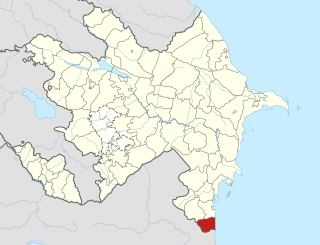
OBERIU was a short-lived avant-garde collective of Russian Futurist writers, musicians, and artists in the 1920s and 1930s. The group coalesced in the context of the "intense centralization of Soviet Culture" and the decline of the avant garde culture of Leningrad, as "leftist" groups were becoming increasingly marginalized.

Astara District is one of the 66 districts of Azerbaijan. It is located in the southeast of the country, in the Lankaran-Astara Economic Region. The district borders the districts of Lankaran and Lerik, as well as the Ardabil and Gilan provinces of Iran. Its capital and largest city is Astara. As of 2020, the district had a population of 110,000.

Jabrayil District is one of the 66 districts of Azerbaijan. It is located in the south-west of the country and belongs to the East Zangezur Economic Region. The district borders the districts of Khojavend, Fuzuli, Qubadli, Zangilan, and the Islamic Republic of Iran.

Zangilan District is one of the 66 districts of Azerbaijan. It is located in the south-west of the country and belongs to the East Zangezur Economic Region. The district borders the districts of Qubadli, Jabrayil, the Syunik Province of Armenia and the East Azerbaijan Province of Iran. Its capital and largest city is Zangilan. As of 2020, the district had a nominal population of 45,200.

Khojavend District is one of the 66 districts of Azerbaijan. It is located in the west of the country in the Karabakh Economic Region. The district borders the districts of Lachin, Shusha, Khojaly, Aghdam, Aghjabadi, Fuzuli, Jabrayil, and Qubadli. Its capital and largest city is Khojavend. As of 2020, the district had a nominal population of 44,100.

Qubadli is a city in Azerbaijan and the administrative centre of the Qubadli District. It is situated along the Vorotan (Bargushad) river.

Chinari is a village in the Berd Municipality of the Tavush Province of Armenia. Chinari lies very close to the Armenia–Azerbaijan border, and is the village closest to the abandoned Khoranashat monastery, which lies on a hill northeast of the town, only feet away from the border.
Syrkhavend or Nor Ghazanchi is a village located in the Agdam District of Azerbaijan, in the disputed region of Nagorno-Karabakh. The village had an Azerbaijani majority prior to their expulsion during the First Nagorno-Karabakh War.
Çullu is a village situated on Goyan steppe, 27 km west of the city of Jabrayil, within the Dagh Tumas administrative-territorial unit of Jabrayil District, Azerbaijan.
Dağ Tumas is a village in the administrative unit with the same name of Jabrayil District of Azerbaijan, located on the southwestern slopes of Karabakh ridge, 23 km to the west of Jabrayil city.
Günəşli, is a village and municipality in the Lerik Rayon of Azerbaijan. It has a population of 1,022. The municipality consists of the villages of Günəşli and Babagil.
Sirik is a village in the administrative unit of the same name, Jabrayil district, Azerbaijan, located on the slopes of the Karabakh ridge, 15 km northwest of the city of Jabrayil.

Char Chinar, also sometimes called Char Chinari, Ropa Lank, or Rupa Lank, is an island in Dal Lake, Srinagar, Jammu and Kashmir. The island located on the Lakut Dal is known as Roph Lank and is marked with four Chinar trees growing at the corners, thus known as Char Chinari. A second chinar island, known as Sone Lank, is located on the Bod Dal and overlooks the shrine of Hazratbal.

The 2012 border clashes between the armed forces of Armenia and Azerbaijan took place in early June. The clashes resulted in casualties on both sides.
Çınar, also spelled chinar and çinar, is a Turkic word meaning "plane tree," derived from the Persian word chenar, and may refer to:

Clashes on the Armenian–Azerbaijan border (Tavush–Qazakh) and the line of contact between the Nagorno-Karabakh and Azerbaijan started on 27 July 2014. Reported casualties of the clashes were some of the highest since the 1994 ceasefire agreement that ended the First Nagorno-Karabakh War.

The Armenia–Azerbaijan border is the international border between the Republic of Armenia and the Republic of Azerbaijan. Estimates of the border's length vary from 996 km (619 mi) to 1,007.1 km (625.8 mi). European routes E002 and E117 cross the border.

The July 2020 Armenian–Azerbaijani clashes began on 12 July 2020 between the Armenian Armed Forces and Azerbaijani Armed Forces. Initial clashes occurred near Movses in Tavush Province of Armenia, and Ağdam in Tovuz District of Azerbaijan at the Armenian–Azerbaijani state border.

Karen Petrosyan v. Azerbaijan was an international human rights case regarding the rights of Artush Petrosyan and his son Karen Petrosyan – an Armenian national from Chinari village, Tavush province of Armenia, who died while in captivity in Azerbaijan in 2014. The judgment of the European Court of Human Rights on the case originated in an application against the Republic of Azerbaijan lodged with the Court under the Convention for the Protection of Human Rights and Fundamental Freedoms by the applicant, Artush Petrosyan, on 25 April 2016. He Submitted that his son had been publicly humiliated, tortured and killed by decapitation by Azerbaijani State agents and that "his son’s body had not been repatriated in a timely manner, that there had been no effective investigation on and that the alleged violations had occurred as a result of discrimination based on ethnic origin".














